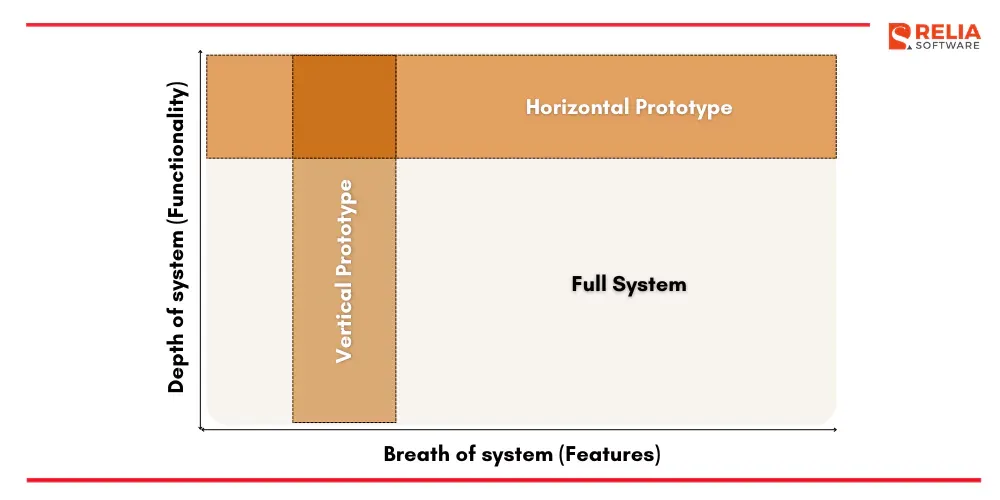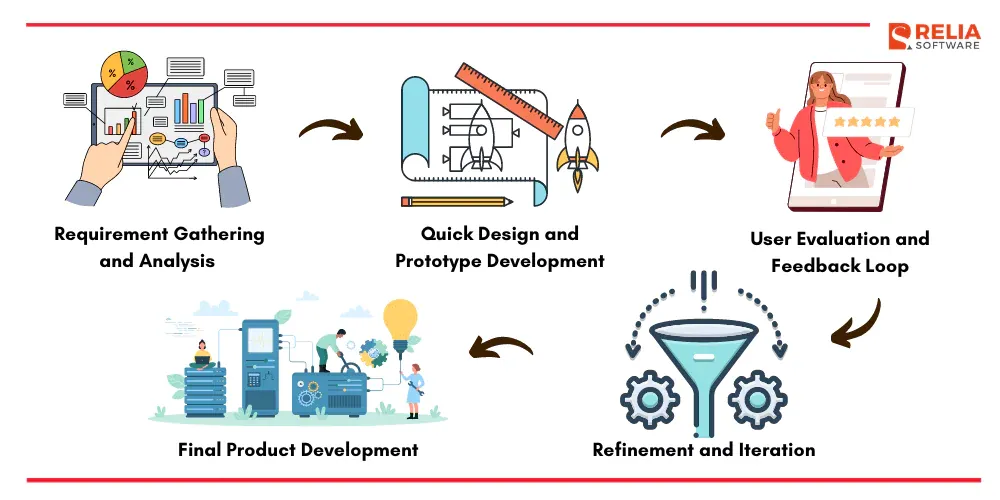Imagine having a great software idea but not knowing how it would work. Will users like it? Will it solve the problems? The prototype model will answer these questions. The prototype model in software engineering is a route from idea to reality. Ideation meets practicality here, creating functional solutions
In this blog, we'll discuss the prototype model's definition, types, phases, pros, and cons. By the end, you'll understand how prototyping can help you make product development decisions.
>> Read more: A Detail Guide of Engagement Models In Software Development
What is Prototype Model in Software Engineering?
The prototype model in software engineering involves developing a basic version of the system, called a prototype, to gather feedback and refine requirements. It allows developers, stakeholders, and users to explore ideas, test functionalities, and visualize the final product.
By using prototypes—ranging from simple wireframes to more complex interactive models—teams can identify potential issues early on and make adjustments. In the end, this iterative process makes a product better meets user needs and expectations.

Types of Prototyping
Low-Fidelity Prototype
A low-fidelity prototype (or "lo-fi" prototype) is a very basic version of the software. It usually includes sketches or wireframes that show the app's structure and flow without going too much into design details.
Low-fidelity prototypes are mainly used in the early stages to brainstorm and test the core concept for meeting stakeholder needs.
High-Fidelity Prototype
A high-fidelity prototype is a software version that are more detailed and interactive, and they look and work a lot like the end product. It include clickable interfaces, functional components, and actual design elements (e.g., colors, typography, and images). These prototypes make sure that certain features work, get feedback on the user experience (UX) in real time, and refine the design via usability testing.
Horizontal Prototype
A horizontal prototype focuses on user interface (UI) and basic functionality without going into specifics of how the app works. This prototype gives a broad view of the system but doesn't get into its architecture or data handling. Horizontal prototypes help visualize front-end development across features without backend integration.
>> Read more: The Difference Between UI and UX
Vertical Prototype
Vertical prototypes delve into a specific application section. Developers can simulate one feature or module to test and improve complex backend procedures. Vertical prototypes can verify technological viability for backend functionality, data structures, and API interfaces. Agile sprints use this prototype to explore technology issues before moving forward.

Evolutionary Prototype
An evolutionary prototype starts with a simple software version and evolves through iterations. Instead of being rejected after testing, evolutionary prototypes are improved until they become the final product.
The evolutionary prototype works well in Agile development, where feedback and iterations are crucial. This method lets teams incorporate user feedback and adjust the design based on new insights. Evolutionary prototypes are flexible and encourage developers, designers, and stakeholders to collaborate.

Incremental Prototype
An incremental prototype is built in iterations that focus on a specific feature or component. Different from an evolutionary prototype, an incremental prototype adds new parts to the system over time. Complex systems with different parts being built in parallel can benefit from this strategy. Testing each module before integration reduces errors and improves product quality.

>> Read more: In-depth Explanation Of Iterative and Incremental Development
Throwaway Prototype
Throwaway prototypes are created to explore ideas or test hypotheses without committing to long-term development. Once their purpose is fulfilled—such as gathering user feedback or validating an approach—they are discarded. Despite this, these prototypes provide valuable insights that guide the final design decisions during the early stages of conceptual design, allowing teams to test multiple ideas quickly.
Extreme Prototype
Extreme prototyping is a software development approach specifically designed for web applications. It breaks web-based system development into 3 phases to speed up the development. Extreme prototyping aims to build and test web application features quickly for immediate user feedback and iteration.
5 Phases of the Prototype Model
Phase 1: Requirement Gathering and Analysis
In this phase, the problem must be defined, and the product concept must be outlined, including core functionalities, user needs, and potential risks. This detailed analysis lays the groundwork for the next development stages and ensures the prototype matches the goal.
Conducting market research to identify your ideal customer and their needs. Then, analyzing competitors’ products helps to point out gaps, trends, and opportunities for your project. You know, understanding what works and doesn't in similar items can guide you create your prototype.
Phase 2: Quick Design and Prototype Development
This stage involves a rapid design. Your teams have to sketch out and brainstorm the initial design ideas, software layout, navigation, and user interactions. This stage is important as the conceptual design serves as a blueprint for the prototype.
With the conceptual design in place, teams move on to developing the actual prototype. Depending on the project’s needs, you can select appropriate techniques such as 3D printing, CAD, rapid prototyping, etc. This prototype is to validate and test the concept early. Then, create a low-fidelity prototype for early feedback or a high-fidelity prototype for extensive testing.
Phase 3: User Evaluation and Feedback Loop
Present the prototype to users and stakeholders after development is complete to get feedback. Their feedback helps enhance the prototype, and usability testing confirms user satisfaction. Real-time testing and adjustments are enabled by feedback loops at this phase.
>> Read more: What is Prototype Testing? Methods & Testing Guide
Phase 4: Refinement and Iteration
With feedback in hand, the prototype is modified and iterated to meet project goals and design principles. Any problems discovered during testing are resolved by design changes. Stakeholders are also kept informed all through this phase. The prototype will improve continuously with the main aim to fulfill user and corporate needs.
Phase 5: Final Product Development
Once the prototype has been fully validated through user feedback and design validation, the final product is developed. This phase uses findings from your prototype to build the full-scale application. Its main aim is to create a scalable solution that fits project goals, technical requirements, and user needs.

Advantages and Disadvantages Of Prototype Model
Advantages
Fewer Misunderstandings: Early clarifying requirements by prototyping helps decrease stakeholder-developer miscommunication. By visualizing the product, prototypes can help stakeholders collaborate and be involved during the software development.
Early Issue Detection: Prototyping helps find design flaws and functional gaps before full-scale development. Iteration cycles with feedback loops and risk management tactics help teams make informed decisions and reduce uncertainty.
Increases Customer Engagement and Satisfaction: Prototypes let you test the user experience to improve the product and match audience needs. Involving customers and stakeholders in prototyping lets them shape the product from the start, improving satisfaction.
Facilitates Marketing and User Testing: Prototypes can be used for early user testing and marketing efforts. They give possible clients or investors a clear model to display and insights on user engagement with the interface.
Reduced Development Costs: Prototyping allows teams to identify potential issues early in the development process, reducing costs later on. By catching design flaws and functional gaps at an early stage, development teams can avoid expensive fixes during the more resource-intensive phases of development. Prototypes in the Agile approach ensure that every iteration solves important issues, hence guiding iterative development towards more affordable manufacturing.
>> Read more: How To Reduce Software Development Costs?
Increased Stakeholder Buy-In: A well-designed prototype can gain stakeholder support and funding because it demonstrates the value and viability of a software project. This may make it easier to win over critical decision-makers.
Disadvantages
Scope Creep: Prototyping can lead to scope creep—when stakeholders request additional features or changes beyond the original plan, increasing costs and timelines. While prototypes encourage exploration, it’s essential to manage expectations and focus on the core objectives.
Time-Consuming: When product improvement requires multiple iterations, prototyping may take time. With complex systems, extra time spent improving the prototype might delay development and deployment.
User Confusion: Users may confuse the prototype with the final product, setting false expectations. If the final product doesn't match the prototype, users tend to be disappointed.
Potential for Poor Solutions: If prototyping is focused only on quick feedback or tight deadlines rather than thorough exploration, it may cause poor solutions. Rapid prototyping is useful, but teams must avoid rash judgments without long-term consequences.
When to Use the Prototype Model?
Prototyping is especially useful in the early stages of development, where iterative development and rapid feedback are crucial to success. Below are some key situations where prototyping proves beneficial:
- New Product Development: When starting something new, prototypes let you test ideas if they match user needs. To test the waters before full-scale development, you can design a minimum viable product (MVP) or a proof of concept (POC).
- Feature Validation: Prototypes can test specific features before integrating them into the final product. This ensures that the features satisfy user expectations and business goals.
- Risky or Complex Projects: In uncertain projects with technical challenges, prototyping lets you spot potential issues early on. It's great for managing risks and tackling difficult technical challenges in tiny increments with continual feedback.
- Unclear or Evolving Requirements: When the requirements are not well-defined, prototyping clarifies expectations and ensures that the final product meets user needs. Besides, Agile methodologies can benefit from prototypes because the need for adaptable designs to meet changing needs and keep stakeholder alignment.
- User Feedback is Critical Early On: Prototyping allows you early usability testing for projects requiring user feedback, including apps with complex UI/UX design. Real-time user testing during prototype development guides teams toward well-informed choices, enhancing user experience.
- Quick Iterations Needed: In domains where rapid iterations are necessary, such as startups or innovative projects, prototyping provides a flexible approach that can adapt to changing needs. Teams that can rapidly test, hone, and iterate on ideas will be able to pivot effectively and reach product-market fit more quickly.
Best Practices for Prototyping in Software Engineering
Get stakeholders involved early. Keep stakeholders aligned with business and user goals to avoid costly changes. It also fosters collaboration and decision-making.
Balance speed and quality. Rapid prototyping provides for quick iterations, but quality must not be sacrificed. Each prototype should combine creative design and technical validation to ensure long-term success.
Use Figma, Sketch, and InVision for prototyping. These tools simplify collaboration, design refinement, and user testing. You can also adapt rapidly your design with real-time feedback.
Avoid skipping evaluation. Rushing a prototype into production rashly can cause problems. Instead, doing extensive usability and design validations before full-scale development. Creating a user-friendly product requires constant feedback and prototype refinement.
Conclusion
The software engineering prototype model allows early validation, reduces risks, and involves stakeholders throughout development. After reading this blog, you can understand and confidently add prototyping to your software development lifecycle. You know, prototyping can significantly improve the chances of a successful software project when properly planned and implemented. I hope your project is successful!
>>> Follow and Contact Relia Software for more information!
- development

